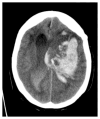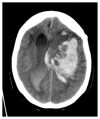Hypertensive Emergency Team-Based Learning
- PMID: 38707946
- PMCID: PMC11068318
- DOI: 10.21980/J8BP90
Hypertensive Emergency Team-Based Learning
Abstract
Audience: The target audiences for this team-based learning (TBL) activity are resident physicians and medical students.
Introduction: According to the Centers for Disease Control and Prevention (CDC), nearly half of the adults in the United States have hypertension,1 which is a leading cause of cardiovascular disease and premature death.2 In extreme cases, patients may present in hypertensive emergencies, defined as an acute, marked elevation of systolic blood pressure >180mmHg or diastolic blood pressure >120mmHg with evidence of organ dysfunction.3,4 Patients presenting to the emergency department (ED) with symptoms of hypertensive emergencies must be promptly diagnosed and treated to prevent further morbidity and mortality. This TBL utilizes four clinical cases to educate resident physicians and medical students not only on the recognition of hypertensive emergencies, but also on the workup, management, and disposition of patients who present to the ED with hypertension.
Educational objectives: By the end of this TBL session, learners should be able to: 1) define features of asymptomatic hypertension versus hypertensive emergency, 2) discuss which patients with elevated blood pressure may require further diagnostic workup and intervention, 3) identify a differential diagnosis for patients presenting with elevated blood pressures, 4) recognize the features of different types of end-organ damage, 5) review an algorithm for the pharmacologic management of hypertensive emergencies, 6) indicate dosing and routes of various anti-hypertensive medications, 7) choose the appropriate treatment for a patient who is hypertensive and presenting with flash pulmonary edema, 8) identify an aortic dissection on computed tomography (CT), 9) choose the appropriate treatment for a patient who is hypertensive and presenting with an aortic dissection, 10) identify intracranial hemorrhage on CT, 11) choose the appropriate treatment for a patient who is hypertensive and presenting with an intracranial hemorrhage, and 12) describe the intervention for warfarin reversal.
Educational methods: This is a classic TBL that includes an individual readiness assessment test (iRAT), a multiple-choice group readiness assessment test (gRAT), and a group application exercise (GAE).
Research methods: Learners and instructors were given the opportunity to provide verbal feedback after completion of the TBL. Learners included senior medical students and first-, second-, and third-year emergency-medicine residents. Learners were specifically asked if they felt the cases were educational, relevant, and useful to their training.
Results: Six resident physicians and three medical students volunteered their verbal feedback, and agreed when they were specifically asked if the cases were educational, relevant, and useful to their training. The same learners also agreed when asked if they felt the TBL was a more enjoyable activity than a direct lecture to refresh their knowledge and skills. One instructor observed that interns and medical students were generally able to reach a correct diagnosis; however, they seemed to struggle more with describing appropriate pharmacologic interventions when compared to more senior learners.
Discussion: Hypertension is a common complaint and incidental finding in patients presenting to the ED. Given its non-specific value, it can be a difficult topic for the novice healthcare provider to master. The differential diagnosis for a patient presenting with hypertension is vast, ranging from benign to emergent, and can sometimes necessitate minimal to substantial workups. Thus, this TBL is a useful, relevant, and effective exercise for residents-in-training to review and understand the management of hypertension.
Topics: Hypertension, hypertensive emergency, asymptomatic hypertension, flash pulmonary edema, aortic dissection, intracranial hemorrhage, warfarin reversal, team-based learning.
© 2024 Tarchione, et al.
References
-
- Centers for Disease Control and Prevention. Facts about hypertension. CDC; 2023. Retrieved 1/23/2023 from https://www.cdc.gov/bloodpressure/facts.htm.
-
- Hacking C. Type A aortic dissection. Radiopaedia. Jun 18, 2015. [Accessed May 28, 2023]. https://radiopaedia.org/cases/type-a-aortic-dissection-4 .























